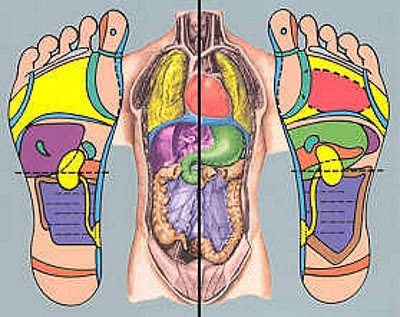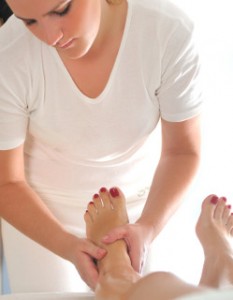
Reflexology is a wonderfully relaxing form of massage which works on the principle that “reflexes” on the feet correspond to every part of the body, including each gland and organ. Applying pressure to these reflexes helps the body heal itself, by relieving tension, improving circulation, and releasing blockages.
Reflexology has been in use for thousands of years. The oldest documented evidence of reflexology in use is a pictograph carved into the wall of the tomb of the physician Ankmahor in Egypt (circa 2330 BC).
The form of reflexology used today first emerged in the early 1900s as “zone therapy”. This paper notes: “Due to its non-invasive, non-pharmacological complementary nature, reflexology is widely accepted and anecdotal evidence of positive effect reflexology in a variety of health conditions are available.”
Over 170 research studies have been conducted into the efficacy of reflexology, of which 90% show reflexology helps a wide variety of conditions, including:
- Constipation
- Diabetes
- Dyspepsia
- High blood pressure
- Inflammatory conditions, including acne, arthritis, bronchitis, rhinitis and sinusitis
- Menstrual issues – including amenorrhea and PMS
- Mental health – including anxiety, depression and stress
- Migraines and tension headaches
- Multiple sclerosis
- Recovery after surgery – including management of pain and nausea
- Pain management – including back pain, labour pain (and decreased labour times), passing of kidney stones, and pain associated with cancer
- Prostate problems
- Stroke recovery
- General well-being
A reflexology treatment should be avoided if you currently have:
- Any foot injuries such as broken bones, skin infections or open wounds
- Fever – your body is busy enough trying to return to health
- Lymphatic cancer – reflexology stimulates the lymphatic system
- Thrombosis – it may increase the tendency for the thrombosis to travel through your system
Please seek medical advice (and if possible, a letter from your GP) prior to treatment if you are pregnant or have:
- diabetes
- epilepsy
- heart conditions
- varicose veins
Best reflexology I’ve had! I always feel so much better and body aligned after a session with Simone! 🙂
Em
What can I expect during my foot reflexology session?

Prior to your first visit, your medical history will be taken via an online form to ensure it is safe to proceed with the treatment and to discern if any areas of the feet should not be worked. (While reflexology can also be applied to the hands or ears, we work the reflexes on the feet with their larger surface area.)
You will need to remove any shoes and socks, and will be assisted to lie comfortably on a massage table. Ladies are advised not to wear a skirt to the treatment, though a sheet or blanket can be provided for cover if necessary. You are encouraged to close your eyes and relax – it is ok if you fall asleep!
A variety of massage techniques will be used on all parts of your feet, starting with a warm up and then working methodically through each reflex. Cream (rather than oil) is applied to reduce friction without making your feet slippery. Firm pressure is applied, so it should not feel ticklish. Some reflexes may be tender or painful. If the pressure on those areas is too much, just let your reflexologist know and they will ease off.
Wonderful. I was so relaxed I fell asleep. Amazing treatment. Thank you.
Janine McKenna
A full treatment will last around 50 minutes. You will need to drink more water to help flush the toxins that have been released during the session out of your body. Don’t be alarmed if the release of toxins during reflexology causes:
- more frequent trips to the toilet
- a headache for a short period afterwards
- a runny nose or eyes (including eyes being sticky on waking)
- pain in problem areas increasing before it subsides
Just had a wonderful relaxing reflexology session. Set me up for the weekend. Thanks Simone
Michele Alexander


